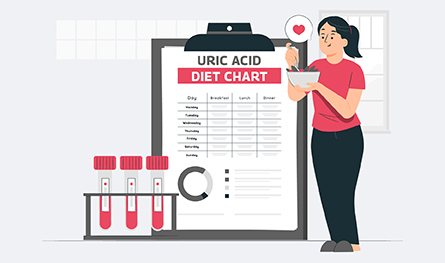Related Articles
 Jan 08, 2025
Jan 08, 2025
Is Varicose Vein surgery covered under the health insurance policy in India
 Health Insurance
Health Insurance

Food not only helps provide nourishment and facilitate survival but can also essentially serve the purpose of medicine. So can be proven by its role in curing and preventing several diseases and health conditions. One such example is excessive uric acid, a common health problem that is a fallout of the body’s inability to throw out the excess acid, resulting in gout. A simple diet plan for lowering uric acid levels in the body can help take care of this condition. This blog looks at the uric acid diet chart for such patients with more quick tips. Keep reading!

Uric acid is what remains in the food digestion cycle after all the food has been absorbed by the body. The surplus uric acid is filtered by the kidneys and excreted through the urine passage. In case the body fails at throwing out the excess uric acid, it begins to deposit itself by way of solid crystals in our joints. This condition is referred to as gout and can often be painful. Excessive production of uric acid in the body or its inability to be excreted from the system adequately may result in higher-than-normal levels of uric acid in the blood.
Let us begin by understanding the primary reasons responsible for elevating the normal levels of uric acid in the blood. Listed below are some of them:
Uric acid generally does not show any symptoms and goes unnoticed for several years even if it increases to a high level. They may show as gout years later with permanently increased levels. When uric acid levels increase continuously, they form crystals, which usually get collected in the large toe, the kidneys, tendon sheaths, bursae, and ear cartilage. If remain untreated, they cause severe pain and swelling in the areas in the form of gout attacks. However, with the right measures and a balanced diet, you can prevent such conditions.
To detect gout, you must check the level of uric acid through a blood test. Men are more likely to develop gout as compared to women. The likelihood of developing gout increases in females when they reach the menopause age. After menopause, the production of estrogen in women stops, which works as a protective layer against gout. Fasting for longer durations as well as eating too much red meat and drinking excessive alcohol may also lead to developing uric acid levels.
Normal levels of Uric Acid in the blood:
Men – 3.5 to 7.0 mg/dl
Women – 2.5 to 5.7 mg/dl
Patients suffering from chronic gout are generally prescribed medications, sometimes for a long term, to keep their condition in healthy check. However, a simpler and perhaps healthier alternative to medicines for gout is eating a diet that is low in fat, which can help in reducing the severity of the problem and provide faster relief from its symptoms. The sections below outline the correct diet for a uric acid patient.
The first step to controlling and also preventing the condition of higher uric acid in the body or gout is to avoid overconsumption of certain food items that increase uric acid levels in the blood. Here we list out some of the common foods that are best avoided in the uric acid diet menu:
We discussed above why patients with high uric acid should control food intake, particularly of some items that can cause more harm than good. Now let us look at some foods that must be included in your diet that can help control and even minimise the symptoms of uric acid:
Given below is a sample diet chart to be followed for uric acid patients. You may make modifications to this as per your taste and preference, or in consultation with a doctor/nutritionist. This uric acid control diet chart is for indicative purposes only.
| Meal of the Day | Food Item |
| Breakfast | Rice idli/rice dosa with sambhar / bajra roti / corn flakes with toned/skimmed milk / vegetable upma / parantha with green chutney / Uttapam with sambhar / whole wheat bread sandwich |
| Mid-day snack | Any fruit of your choice – pear, orange, muskmelon, guava, banana, pineapple |
| Lunch | Brown rice with rasam / jowar roti with any vegetable of your choice – mooli sabzi, bottle gourd, ivy gourd, potato brinjal sabzi, capsicum |
| Evening snack | Green tea with biscuit |
| Dinner | Jowar/bajra roti with ladyfinger/cauliflower sabzi / ridge gourd / tinda / raw banana sabzi |
Here are some more quick tips to deal with uric acid issues in the body by ensuring that you follow a controlled diet. Food can play a vital and helpful role in regulating the levels of uric acid in your body. If we can take care of what we eat, uric acid and gout can be controlled and prevented to a large extent.
| Do’s | Don’ts |
| Add vegetables to each meal you eat | Don’t drink cold drinks, sweets, cakes, donuts, chips, and other packed food items. |
| Drink plenty of water all through the day | Don’t skip a meal and don’t snack between meals |
| Consume food in small portions | Eat slowly and chew each bite well |
| Exercise 30 minutes to 1 hour every day – include brisk walking and cycling | Don’t pick food from the supermarket without consideration |
| Be aware of what you eat and what you buy for grocery | Don’t consume more than 2-3 pieces of fruit in a day |
High Uric Acid levels can be controlled by changing your eating habits and diet. However, if changes in diet don’t reduce the level of uric acid, you will have to take medication. Medicines will reduce the production of uric acid or may help eliminate uric acid from the kidneys. Gout attacks can be treated through medicines as well. Further, you may use cold compresses for significant and quick relief.
Vegetables, fruits, and whole grains are considered to be the best foods to be consumed by patients with gout or excessively high uric acid levels in the body.
Toor dal is believed to be helpful as it lowers uric acid levels in the body.
Some of the common symptoms to look out for are:
# Stiffness in joints
# Redness or swelling particularly around the joints
# Misshaped joints
# Severe pain in the joints
# Difficulty in movement of joints that are affected

Paybima Team
Paybima is an Indian insurance aggregator on a mission to make insurance simple for people. Paybima is the Digital arm of the already established and trusted Mahindra Insurance Brokers Ltd., a reputed name in the insurance broking industry with 17 years of experience. Paybima promises you the easy-to-access online platform to buy insurance policies, and also extend their unrelented assistance with all your policy related queries and services.
.png)
Fixed Deposits (FDs) are one of the most popular and safest investment options in India. Among the various banks offering FD schemes, Equitas Small Finance Bank stands out for its competitive interest rates and flexible investment plans. If you're thinking of investing in Equitas Fixed Deposits in 2025, this guide will help you understand the FD calculator, eligibility criteria, and the interest rates offered by the bank.

.png)
Taking a personal loan is a big financial decision, and one of the smartest things you can do before applying is to calculate your monthly EMI. If you're considering a loan from Punjab National Bank (PNB), the PNB Personal Loan EMI Calculator is your best friend.

.png)
Learn everything you need to know about the Post Office Fixed Deposit (FD) scheme, including the FD calculator, eligibility criteria, and 2025 interest rates. Discover the benefits of investing in this secure and government-backed savings option, along with the new FD scheme introduced for senior citizens. Whether you're a beginner or experienced investor, this guide will help you make an informed decision for your financial future.

.png)
Are you planning to take a personal loan from SBI (State Bank of India)? One of the first steps in smart loan planning is to calculate your monthly EMI—so you know how much you’ll pay and whether it fits your budget.
That’s where the SBI Bank Personal Loan EMI Calculator comes in handy. In this blog, we’ll explain what it is, how it works, how to use it, and why it’s an essential financial tool before applying for a loan.

.png)
Saving money is always a wise choice, especially when you want it to grow safely over time. One of the most trusted and traditional ways to do that in India is through Fixed Deposits (FDs). The Bank of Maharashtra, a government-owned public sector bank, offers excellent FD schemes with competitive interest rates and flexible options for different types of investors.
